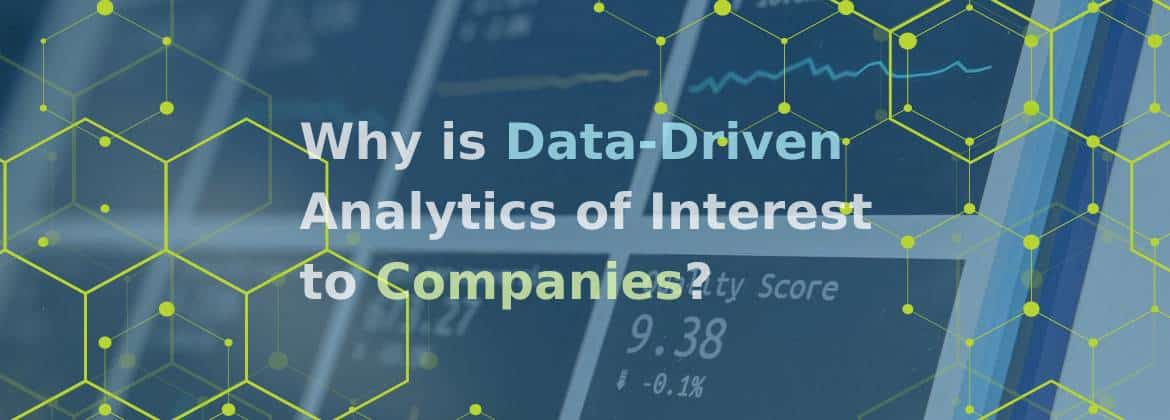Why is Data-Driven Analytics of Interest to Companies?
We gathered our Data Scientists and Growth hackers to answer Why is Data-Driven Analytics of Interest to Companies in 2022. These days you are constantly hearing about the “data-driven approach” and how companies around the world are starting to develop a data-driven model to make better and more informed decisions about the future steps of the company and the strategies in place at the moment.
But how does this work precisely, and why is data-driven analytics of interest to companies?
At Inspiral Growth – our Growth Hacking Agency, we are huge fans of data and what it tells us about a company at a given moment in time. We want to share with you several reasons why you may want to consider this modern approach for your business.
Let us dive right into it.
But first
What is a data-driven company?
Companies whit this particular approach use big data to develop business solutions that provide constant growth and improvement for the company’s present and future.
And from where is this data coming?
Well, we are basically sharing our information constantly in this digital world. Every time you fill up a form, subscribe to a newsletter, visit a website and leave, visit a website and buy something, almost all of our movements on the internet leave a trace that companies use to elaborate all types of strategies.
This data shows the behavior people have towards the market. Different businesses can use data to improve their performance and to take advantage of the gaps the market often offers.
It sounds scary; indeed, data can be used for obscure purposes, but most companies want to improve their margins and sales, which is entirely natural.
Data analysis is here to stay because it keeps proving itself effective, not only for making predictions but for talking about the present and how to improve what already exists.
Here are some of the benefits of data-driven analytics for companies, regardless of their niche.
Allow companies to find solutions.
How many times as a business owner have you found yourself in a situation you do not know precisely how to get away from? This is pretty common on the road of businesses and brands to success.
However, when you have data at your disposal, you can find creative solutions to business problems containing your brand for the exponential growth it can have.
For example, let us say you want to launch a new product on the market, and you are not exactly sure if the people would react positively or negatively to it. A data-driven decision would be to use the previous data from the market and see how people have responded to similar products in the past or over a certain period.
- What are people looking for when looking for this product or service?
- What do customers prefer not to deal with?
- Are there other companies that have been successful with similar products or services?
These are just some of the questions you can find answers to in the data-driven world. And this is just an example applied to the marketing world, but you can take this decision-making process to almost any area you can think of.
Data Analytics is very popular in the sports world, especially in sports like Basketball and Football.

Fun fact:
Did you know the Soccer player Kevin De Bruyne used Data Analytics through the process of getting his contract renewal? He was tired of dealing with agents and agency companies, so he decided to take control and hired an Analytics company. Experts from this company analyzed all the vital statistics for a player of his position and determined Kevin’s influence on the team’s week-to-week results.
In the end, Kevin got his contract renewal with a juicy salary increase due to the massive importance of his game for the Manchester City team.
Data finds creative solutions to common problems.
But in other contexts, a data-driven culture allows finding solutions to problems without human intervention.
Tip # 1 It can save you time and money.
Once again, thinking in marketing, let us say you create a content strategy to promote your brand, but the results are not quite what you expect them to be.
How can you know which content generates your brand leads, interaction, or visibility?
After all, creating content costs money. You have to pay designers, content creators, social media management, paid advertising specialists, and other professionals if you want to deliver the most incredible experience to your potential customers (and have a good return on investment).
You can find the data these tools collect regarding position tracking and people’s interaction with your content by going into Google Analytics and Google Search Console.
Sometimes, we hear terms like some of the ones we have used in this article, like “big data” and “data-driven analytics,” and we think that the world is just for those with the ability to perform complex mathematical analysis. But the reality is that there are levels for data analysis and different ways to approach it.
Position tracking tools like the ones mentioned above will provide data as simple and complex as you want or need it. With that data, you can, for example, determine which type of content generates the most engagement with your audience and try to copy that into the ongoing strategy.
Tip # 2 It allows you to conduct experiments and make more informed decisions.
One of the reasons why Growth Hacking keeps gaining popularity is because it relies heavily on the data to create different strategies for businesses looking for a way to reach exponential growth in a significantly small window of time.
Growth hacking is all about experimentation and testing different approaches for different outcomes. Finally, you end up with the best strategy based on the data extracted from the experiments so your business can reach its potential in no time.
It is easier to make business decisions when you know what works and does not. Decisions based on data and analysis tend to be more accurate since data usually reflects people’s behavior towards something.
At our Growth Hacking Agency – Inspiral Growth, experimentation is our motto, carpe diem, and way of life. That is why we have created a Solution Center for entrepreneurs like you, looking to make the best out of the massive investment that represents starting a business and a brand from scratch.
At our Growth Hacks Webshop, you can find quick and easy growth hacking products and services that will put your brand in front of the right people. The best part is that no matter which product you choose, we offer you the possibility to have a 30-minute session over the phone or zoom to discuss the results of the hacks and whatever other thing we can squeeze in those 30 minutes.
The digital world accepts no improvisation when it comes to validation.
Tip # 3 Follow the data and get the results you have been looking for.
We are passionate about brands and entrepreneurship. We want to connect with similar minds and grow together.
Did you know that there are four different sorts of Data Analytics?
You probably already agree that Data Analytics is a crucial factor in the informative Era.
Everything starts with defining your metrics or KPIs. There are tons of Data available nowadays; you need to know why you are measuring a metric before even creating frameworks for measuring it. So let us share with you a more extensive description of the types of Data Analytics that may be part of the lifespan of your company and how to identify if they are necessary for you.
The four sorts of Data Analytics:
-
Number One: Descriptive analytics
The most common is Descriptive analytics, which answers what has happened to our business in a defined timeframe. Most of the Tools used by Marketing Departments start with Descriptive analytics to optimize target audiences, online channels, sales funnels, and much more.
Most companies focused on traction and client acquisition may benefit from Descriptive Analytics. As a Growth Hacking Agency, we would even dare to say that nowadays, every company looking to compete in the digital world must have descriptive analytics tools in place.
Examples: If you are doing paid advertising, then your Social Media Ads offer platforms with Data Analytics about your leads. If you use CMS platforms such as Shopify, WordPress, and Hubspot, they also provide Data Analytics about your visitors. If you are working on content marketing and SEO, some essential tools to start with descriptive Analytics are Google Search Console and Google Analytics A4.
-
Number Two: Diagnostic Analytics
Which deepens in answering the question of why something happened with our business. Think about the many times you visited a doctor after doing a Blood Test. The Doctor reviews the results and delivers a diagnosis on what may or may not be happening in your body. Here is where the Doctor’s experience and knowledge interact with your test results.
Now let’s consider that a team of professionals diagnoses the results obtained from the analysis of your company. They combine your data with other data sets in the same or similar markets to draft a hypothesis on the events you want to understand.
Example: The marketing team uses diagnostic Analytics with a Mixpanel Software, for example, to understand why a summer campaign worked this year in the US and why the same campaign did not work in Europe.
The Investment team uses diagnostic Analytics with their Stock Exchange Tools to understand the results of your portfolio in the past years to compare them to global events and their correlation. The Administrate team uses diagnostic Analytics with the Deputy Software, for example, to understand how the labor costs in your company were affected in the past years with the pandemic and remote work teams.
-
Number Three is Predictive Analytics
Aims to predict as closely as possible what will happen in your business’s future. It is becoming a trend in digital companies. And in the past 20 years, new careers have appeared that specialize in this segment, including Data Engineers and Data Scientists. Growth Hacking also appeared in the marketing world due to the fast-changing Digital Market.
ScaleUps and Corporates are certainly applying Descriptive and Diagnostic Analytics, yet Predictive Analytics is still in development for most. To implement practical Predictive Analytics, you must consider first that some business decisions can be improved just by applying a diagnostic Analytics process.
It would help if you started by having a clear Decision Tree Map. It can help you filter business decisions that would be suitable to reach this analysis stage. This approach will save you time and money as you may find out you don’t need to hire a Data Engineer just because it is the new trend.
Example: The CEO of a Heating Systems Company decides to launch a new product in the following winter Olympics, and you are in charge of finding the best suitable option. You may study how your product segments’ sales were affected in the last eight years, considering the Olympics happen every four years.
You might even find a correlation between other winter events and the variation in sales. Moreover, you have gathered enough Data with the team of marketing and finances to predict what kind of Heating solution could deliver the best ROI.
You present your conclusion to the CEO and move to the next challenge. And indeed, you don’t need to apply Machine Learning or AI in these less frequent business decisions.
-
Number four is Descriptive Analytics
Which has to do mainly with increasing your level of success with future business decisions. The previous example also used descriptive analytics, yet let’s consider now a higher grade of complexity. Your company is looking to improve a business decision frequently affecting your product.
And what decision the company will make with the results of your predictive analysis. You have used your Decision Tree Analysis and concluded that you could use the help of Machine learning to solve it. The next step for you is to get the right team to implement it.
A team that would be able to dissect the problem and obtain and curate the right Data sets. Moreover, a group would be able to create the proper infrastructure to deploy your experiments.
Example: If you are one of the Netflix users, you know by now what I’m talking about from your own experience. It seems like Netflix studies every movie or series you have chosen and delivers a list of recommendations for you to watch next.
How many times have you thought you would cancel their services till the moment one of those recommendations kept you interested? Then you decided to keep your subscription to see that new series you suddenly discovered? I know I have.
Better yet, have you considered the possibility that many of those series are created following specific formulas of previous success? And that these formulas result from the endless analysis of millions of clicks ad patterns of their users? I’m just guessing. Right?
Now that you know the four sorts of Data Analytics
think about the following: Many companies and professionals talk about Becoming Data-Driven, yet the actual goal is to be Data Informed. How? Well, there is much more to tell still. Don’t worry! We will right here in our Inspiral Growth Educational Blog.
Finally, for our team of Growth Hackers, Always learning is one of our most essential habits. And always learning goes hand in hand with why is Data-Driven Analytics of Interest to Companies.
The future belongs to the brave. Are you one of them? Let us connect!



